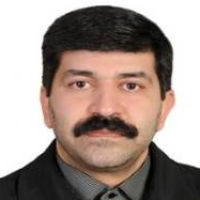Evaluation of grain yield stability of barley genotypes using additive main effects and multiplicative interaction model
Author(s):
Article Type:
Research/Original Article (دارای رتبه معتبر)
Abstract:
Objective
Barley as one of the most important cereals is crucial to supplying the required energy for both humans and animals. Grain yield is strongly influenced by environmental conditions and breeders often determine the stability of high-yielding genotypes across various locations before recommending a cultivar for release.Methods
For this research, 18 barley genotypes were tested at four different research stations including Gachsaran, Moghan, Khorramabad, and Gonbad in Iran. The additive main effects and multiplicative interaction (AMMI) model was used to identify the stable genotypes.Results
Partitioning of the GE interaction indicated that the first interaction principal component axes (IPCA) captured 35.9% of the interaction sum of squares. However, the five IPCAs accounted for 87.4% of the total interaction. Moreover, 13 AMMI-based stability statistics were calculated. Using cluster analysis, AMMI stability indices were divided into four groups. This analysis showed that most indices do not correlate with the grain yield. AMMI indices were placed in separate groups with large distances from the grain yield. However, the yield stability index (YSI) showed the highest correlation with grain yield, and based on that, G13, G18, and G11 genotypes were recognized as superior genotypes. G13 and G18 genotypes had an acceptable performance in two years and four locations, so they may be regarded as genotypes with both high yield and stability in these environments. However, by using the AMMI2 mega-environmental analysis to select suitable cultivars for each mega-environment, the target region was divided into three sub-regions, and the winner genotypes of each sub-region were identified. The first mega-environment consisted of the areas Gonbad and Ghachsaran, where genotype G14 was the winner; the second mega-environment consisted of the Khorramabad area, where genotype G2 was the winner, and the third mega-environment included only the Moghan area, where genotype G13 was the winner.Conclusion
In conclusion, the AMMI2 mega-environmental analysis identified three mega environments and the best genotypes specifically adapted to these environments. Since two test areas Gonbad and Ghachsaran were located in the first mega-environment, it seems that the performance ranking of the test genotypes in these areas will be almost the same, and in coming years, the test can be performed in only one of these areas.Keywords:
Language:
English
Published:
Journal of Plant Physiology and Breeding, Volume:14 Issue: 1, Winter-Spring 2024
Pages:
51 to 66
https://www.magiran.com/p2815765
سامانه نویسندگان
اطلاعات نویسنده(گان) توسط ایشان ثبت و تکمیل شدهاست. برای مشاهده مشخصات و فهرست همه مطالب، صفحه رزومه را ببینید.
مقالات دیگری از این نویسنده (گان)
-
Evaluation of essential oil compounds diversity in dill (Anethum graveolens L.) accessions under field conditions
*, Mehdi Mohebodini, Afsaneh Gholizadeh
Taxonomy and Biosystematics, -
Grouping promising durum wheat lines for frost resistance using some morphophysiological traits
Fatemeh Mohamadi Azar, *, , , Rahmatollah Karimizadeh
Journal of environmental stresses in crop sciences, -
The effect of organic nanofertilizer and fulvic acid on yield, amino acids composition and protein percentage of wheat grain under water deficit conditions
Ahmad Tobeh, Khadijeh Aghaeifard*, Yavar Dargahi, Keramat Akhavan,
Crop physiology journal, Winter 2025 -
Investigating the effect of salinity stress on photosynthesis and physiological traits of different lentil cultivars and its relationship with molecular markers
Nasrin Mehdinejhad Moghadam, *, Naser Zare, Mohamad Sedghi, Rahmatollah Karimizadeh, Fatemeh Mohamadiazar
Nova Biologica Reperta, -
Genetic Analysis of Yield and Some Agronomic Traits of Hybrid Maize Under Well- Irrigated and Water Deficit Conditions
Mozhgan Shirinpour *, Saeid Aharizad, Ehsan Atazadeh, Ashkboos Amini, Ali Asgheri, Ahmad Bybordi, Hassan Monirifar
Journal of Agricultural Science and Sustainable Production, -
فراز، رقم مناسب جو جهت کشت درمناطق گرمسیری و نیمه گرمسیری دیم کشوربرای مصرف علوفه
بهروز واعظی*، ، رحمت الله محمدی، طهماسب حسینپور، محبوبه دری، ثریا قاسمی، مظفر روستایی، فرهاد اهک پز، عباس خانیزاد، امین نامداری، معصومه خیرگو، رحیم هوشیار، رضا اقنوم، صفر صفوی، فرشید محمودی
نشریه علوفه و خوراک دام، پاییز و زمستان 1399





